Recent Posts
Central Park West Commercial Water Damage Restoration Project: A Comprehensive Overview
8/3/2023 (Permalink)
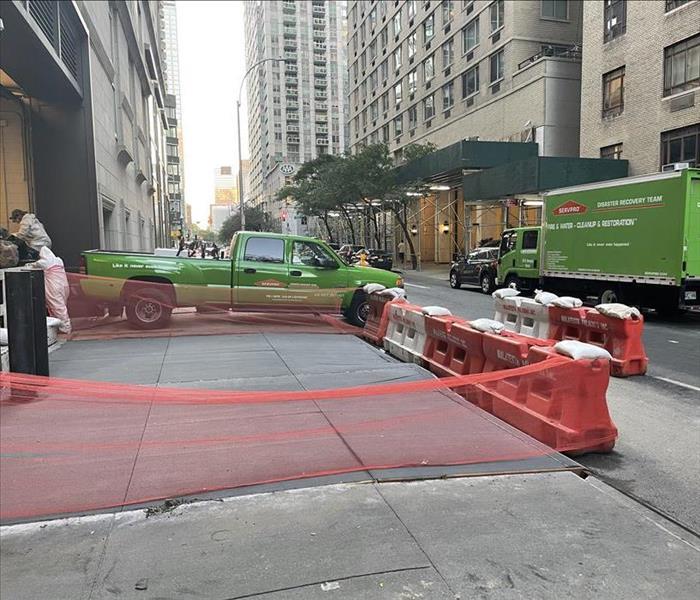 Our Disaster Recovery Team can respond to commercial water damage projects nationwide!
Our Disaster Recovery Team can respond to commercial water damage projects nationwide!
The Central Park West Commercial Water Damage Restoration Project stands as a testament to the expertise and efficiency of SERVPRO Team Bisig. Faced with a catastrophic scenario after Hurricane Ida's fury, the team managed to turn the tide in a situation that could have been detrimental for this high-end apartment complex. Here's a detailed look at the challenges, actions, and outcomes of this massive restoration project.
The Challenge: A Disaster Unleashed by Hurricane Ida
Hurricane Ida will be remembered for its destructive force, and the Central Park West apartment complex faced the brunt of it. The subway system below the building became flooded, resulting in a rupture of the concrete slab that formed the basement's foundation. The entire basement area, spanning an incredible 60,000 sq ft, was filled with water. The potential damage was not only to the structure but also to the electrical systems and other vital components housed in the basement.
Immediate Response: Mobilizing SERVPRO Team Bisig
Time was of the essence, and SERVPRO Team Bisig was mobilized quickly to assess and contain the situation. The team's first priority was to stabilize the building to prevent any further structural damage. This involved pumping out the floodwaters and taking measures to ensure that the integrity of the foundation was maintained.
Water Damage Restoration: A Multifaceted Approach
The water damage restoration process was complex and multifaceted. It involved:
- Water Extraction: Industrial pumps and vacuum units were used to remove thousands of gallons of water.
- Structural Drying: Specialized equipment was utilized to dry the structure completely, including the use of dehumidifiers and air movers.
- Decontamination: The floodwater had brought contamination into the building. Thorough cleaning and sanitization were essential to prevent health hazards.
- Concrete Slab Repair: The rupture of the concrete slab required skilled engineering to repair and reinforce.
- Electrical and Mechanical Systems Restoration: The water had affected the basement's electrical and mechanical systems. These were carefully restored to full functionality.
- Interior Restoration: Some of the interior finishes and components needed repair or replacement, including walls, floors, and fittings.
Financial Overview: A Project Worth $2.5 Million
The total cost of this restoration project reached $2.5 million. This figure reflects not only the magnitude of the damage but also the comprehensive approach taken to restore the building to its preloss condition. Insurance and financial arrangements were handled with professionalism and efficiency.
The Outcome: Success Against the Odds
The Central Park West Commercial Water Damage Restoration Project was completed successfully, with the building restored to its former glory. Residents were able to return to their homes, and the potential long-term damage was averted.
Conclusion: SERVPRO Team Bisig - A Name to Trust
The restoration of the Central Park West apartment complex underscores SERVPRO Team Bisig's expertise in commercial water damage restoration. Their ability to respond swiftly, mobilize resources, and execute a restoration plan with precision makes them a trusted name in the industry.
For those in need of water damage restoration services, whether due to a natural disaster or other causes, SERVPRO Team Bisig is ready to assist. Their commitment to excellence ensures that even the most challenging situations can be handled with professionalism and care.
Get Disaster-Ready with SERVPRO's ERP: A Must-Have for Every Property Owner
5/23/2023 (Permalink)
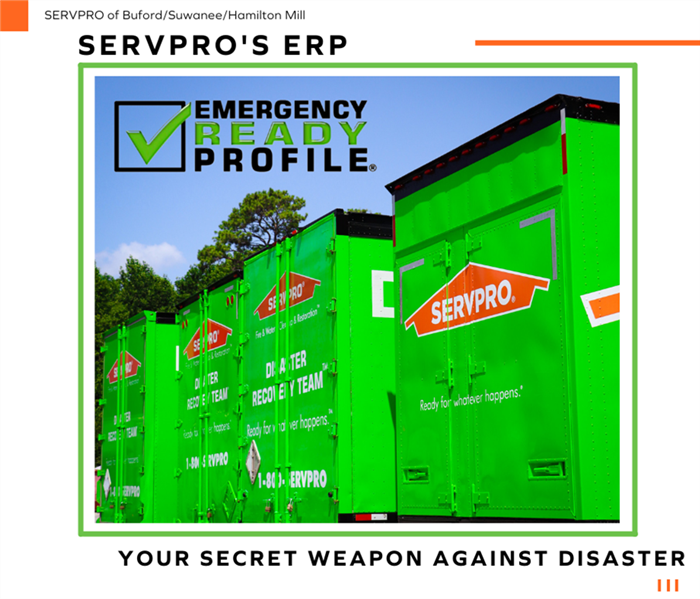 Our ERP Program can protect your business from unexpected disaster here in Buford, GA. Whether it's water, fire, wind, or mold, we're here to help.
Our ERP Program can protect your business from unexpected disaster here in Buford, GA. Whether it's water, fire, wind, or mold, we're here to help.
Dealing with an unexpected disaster can be daunting. It brings chaos, panic, and uncertainty. But wouldn't it be comforting to have a go-to plan in place? That's exactly what we offer at SERVPRO of Buford/Suwanee/Hamilton Mill with our Emergency Ready Profile (ERP) program.
Understanding SERVPRO's ERP
The ERP, or Emergency Ready Profile, is a strategic tool developed by SERVPRO to assist property owners in planning for unforeseen disasters. Think of it as a quick reference guide for your property, filled with critical information you need during an emergency.
Why an ERP is Essential
An emergency isn't the time to start figuring out who to call or where your main water shut-off is. Time is of the essence when disaster strikes. Your ability to respond quickly can mean the difference between minor damage and major disaster. The ERP provides all the vital details such as shut-off valve locations, critical areas of your property, and essential contact information. It allows you to act promptly, mitigating damage and reducing downtime.
Getting Started with an ERP
Setting up an ERP with SERVPRO of Buford/Suwanee/Hamilton Mill is simple and free. Here's what the process entails:
- Evaluation: We perform a free assessment of your property to document its unique features.
- Profile Development: We create a detailed profile document containing all essential information needed in an emergency.
- Strategy Formulation: We help you develop a strategic plan for various emergency situations to minimize property damage and business interruption.
- Training: We ensure that you and your team know how to access and use the ERP.
- Accessibility: Your ERP is available online or via the SERVPRO Ready Plan mobile app, which is accessible on iOS and Android devices.
Experience Peace of Mind with SERVPRO's ERP
An ERP from SERVPRO of Buford/Suwanee/Hamilton Mill does more than prepare you for a disaster; it gives you peace of mind. It assures you that you're equipped to handle any emergency effectively and efficiently.
Equip Yourself with SERVPRO's ERP
Don't let an unexpected disaster catch you off guard. Be ready with SERVPRO's Emergency Ready Profile. Contact our SERVPRO of Buford/Suwanee/Hamilton Mill team today at (770) 945-5355 to schedule your free ERP consultation. It's not about waiting for a disaster; it's about being ready when it strikes. Let us help you ensure it’s "Like it never even happened."
Navigating Insurance Claims for Water Damage: Expert Tips and Tricks
3/28/2023 (Permalink)
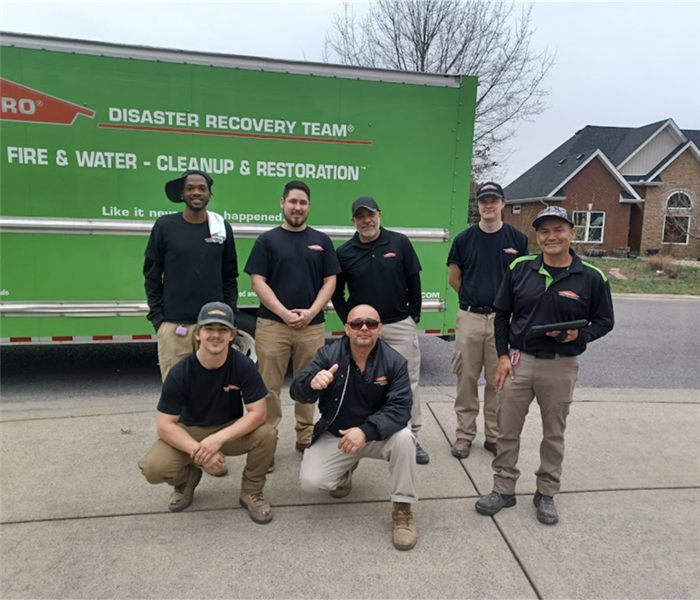 SERVPRO of Buford/Suwanee/Hamilton Mill is available 24/7/365 to respond to your emergency flood removal and water damage cleanup needs.
SERVPRO of Buford/Suwanee/Hamilton Mill is available 24/7/365 to respond to your emergency flood removal and water damage cleanup needs.
Dealing with water damage can be a stressful and overwhelming experience. Whether it's due to flooding, a burst pipe, or a leaking roof, water damage can wreak havoc on your property, possessions, and peace of mind. One of the critical aspects of handling water damage is navigating the insurance claims process. Knowing what to expect and how to maximize your claim can make a significant difference in your recovery. With many years of experience serving Buford, Suwanee, Hamilton Mill and surrounding areas, we wrote this blog to provide expert tips and tricks on navigating insurance claims for water damage. This way, you can secure the compensation you deserve while ensuring a smooth claims process.
Understanding Your Insurance Policy
The first step in navigating insurance claims for water damage is understanding your insurance policy. It's crucial to be familiar with the terms and conditions, as well as the extent of coverage provided. Some policies cover water damage from sudden and accidental events, while others exclude specific causes such as flooding. Here are a few tips to help you understand your policy:
- Review your policy documents and declarations page, which will outline your coverage limits and deductibles.
- Identify the specific perils covered and any exclusions, paying close attention to water damage-related incidents.
- Contact your insurance agent or company if you have any questions or need clarification about your coverage.
Documenting the Damage and Initiating the Claim
Once you have a clear understanding of your policy and coverage, it's time to document the damage and initiate your claim. Proper documentation is crucial in ensuring that your claim is processed accurately and efficiently. Follow these steps for documenting the damage:
- Take photographs and videos of the affected areas and any damaged items. Be thorough and capture images from different angles to provide a comprehensive visual record.
- Create a detailed inventory of damaged items, including their age, purchase price, and replacement cost.
- Keep receipts and invoices for any expenses related to the water damage, such as temporary accommodations or emergency repairs.
After documenting the damage, contact your insurance company to initiate the claim process. Be prepared to provide the necessary information, including the cause of the water damage, the extent of the damage, and your policy number.
Working with Commercial Restoration Services
In many cases, the best way to address water damage is by working with professional commercial restoration services. These experts have the knowledge, experience, and equipment needed to effectively mitigate and repair water damage. When selecting a water damage restoration company, consider the following:
- Choose a reputable company with experience in handling insurance claims like SERVPRO of Buford/Suwanee/Hamilton Mill. We can help you navigate the claims process and work directly with your insurer.
- Verify that the company is licensed, insured, and certified by industry organizations such as the Institute of Inspection, Cleaning and Restoration Certification (IICRC). Our technicians are trained through industry leading IICRC programs for your peace of mind.
- Request references and read reviews to ensure the company has a track record of success in water damage restoration. With over 150+ 5 star google reviews, our team has a track record of success that you can trust.
Involving commercial restoration services early in the process can expedite the insurance claim and increase the likelihood of a favorable outcome. These professionals can provide detailed estimates, documentation, and evidence to support your claim, ensuring you receive fair compensation.
Conclusion
Navigating insurance claims for water damage can be a daunting task, but with the right approach and assistance from professional commercial restoration services, you can successfully secure the compensation you deserve. By understanding your policy, documenting the damage, and working with experienced water damage restoration experts like our SERVPRO team, you can minimize the stress and financial burden associated with water damage recovery.
In case you need help with your water damage restoration project, give us a call at (770) 945-5355. We’re always here to help!
The Link Between Water Damage and Indoor Air Quality: Tips to Protect Your Health
3/28/2023 (Permalink)
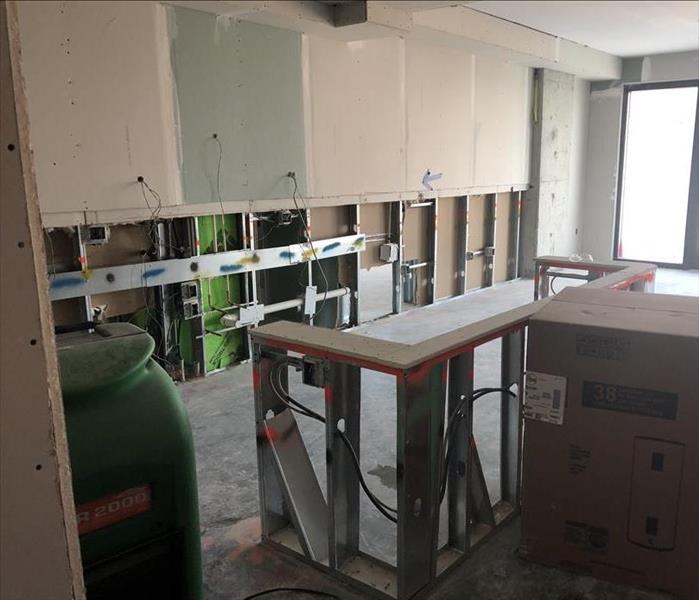 SERVPRO of Buford/Suwanee/Hamilton Mill successfully completed this commercial mold remediation in Buford, GA. Call us if you need mold removal!
SERVPRO of Buford/Suwanee/Hamilton Mill successfully completed this commercial mold remediation in Buford, GA. Call us if you need mold removal!
Water damage can have severe consequences on your property and belongings, but one often overlooked aspect is the impact on indoor air quality. Poor air quality resulting from water damage can lead to numerous health issues and discomfort for occupants. In this blog post, we will explore the link between water damage and indoor air quality, and share tips on how to protect your health. We'll also discuss how SERVPRO of Buford/Suwanee/Hamilton Mill can help you tackle these issues efficiently and effectively.
How Water Damage Affects Indoor Air Quality
Water damage creates the perfect environment for various contaminants to thrive, which can have a negative impact on indoor air quality. Some of the most common problems arising from water damage include:
- Mold growth: Mold thrives in damp conditions and can begin to grow within 24-48 hours after water intrusion. Mold spores can become airborne, potentially leading to respiratory issues, allergies, and even more severe health problems.
- Bacteria and viruses: Water damage, especially from sources like sewage backups or floodwaters, can introduce harmful microorganisms into your living space, contaminating the air.
- Unpleasant odors: Musty odors are common after water damage, resulting from mold growth and the breakdown of organic materials.
Health Effects of Poor Indoor Air Quality
Although scientists are still studying the effects of poor air quality on health, some cases have shown that exposure to poor indoor air quality due to water damage can result in various health issues. These can range from mild discomfort to more severe conditions. Some of the potential health effects include:
- Respiratory problems: Mold spores, bacteria, and other contaminants can irritate the respiratory system, leading to coughing, wheezing, and difficulty breathing.
- Allergic reactions: Exposure to mold and other allergens can trigger allergic reactions, such as sneezing, runny nose, and itchy eyes.
- Asthma exacerbation: Individuals with asthma may experience worsened symptoms due to poor indoor air quality.
- Infections: In some cases, exposure to harmful microorganisms can result in infections, particularly for individuals with weakened immune systems.
Tips to Protect Your Health and Improve Indoor Air Quality
To protect your health and improve indoor air quality after water damage, consider the following tips:
- Act quickly: Address water damage as soon as possible to minimize the growth of mold and other contaminants.
- Control humidity: Maintain indoor humidity levels between 30-50% to discourage mold growth and improve overall air quality.
- Ensure proper ventilation: Make sure your home is well-ventilated to help remove moisture and contaminants from the air.
- Use air purifiers: Consider using air purifiers with HEPA filters to capture airborne particles and improve indoor air quality.
- Regularly clean and maintain your HVAC system: This will ensure that it is not spreading contaminants throughout your home.
How SERVPRO of Buford/Suwanee/Hamilton Mill Can Help
SERVPRO of Buford/Suwanee/Hamilton Mill is a trusted provider of water damage restoration and indoor air quality improvement services. Our team of expert water damage restoration technicians is equipped to handle all aspects of water damage recovery and can help you safeguard your health. Some of the benefits of working with SERVPRO include:
- 24/7 rapid emergency service: We aim to be faster to any size disaster. So, fast response is crucial in mitigating water damage, and our SERVPRO team is available around the clock to assist you.
- Highly trained technicians: SERVPRO's professionals are IICRC certified and receive ongoing training to stay updated on the latest techniques and technologies.
- Advanced equipment: SERVPRO uses state-of-the-art equipment for water extraction, drying, dehumidification, and air purification to ensure a thorough and efficient restoration process.
Conclusion
Water damage can have a significant impact on indoor air quality, potentially leading to various health issues for occupants. By acting quickly, controlling humidity, ensuring proper ventilation, and using air purifiers, you can minimize these risks and protect your health. Trust SERVPRO of Buford/Suwanee/Hamilton Mill to provide expert water damage restoration and indoor air quality improvement services. Their team of professionals, available 24/7, will work diligently to help you recover from water damage and restore a healthy living environment.
What to Know About Weather Alerts To Keep Your Home Stay Safe | SERVPRO® of Buford/Suwanee/Hamilton Mill
7/12/2022 (Permalink)
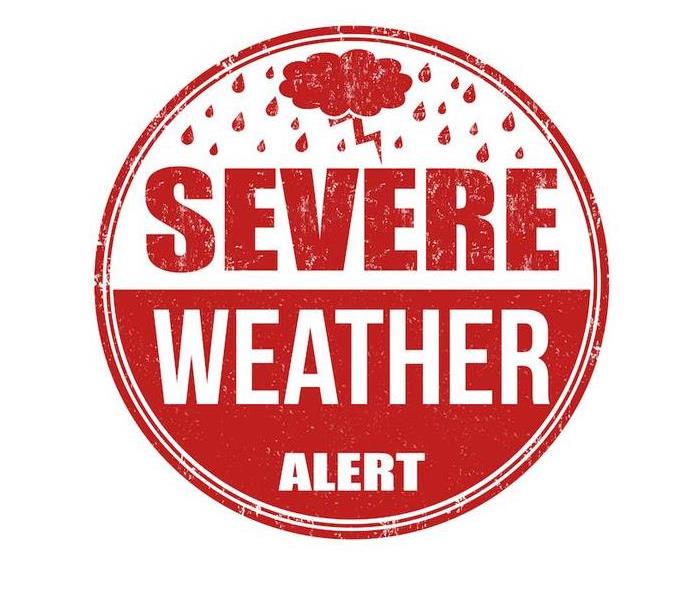 If you suspect any damage to your home from a recent storm, call SERVPRO of Buford/Suwanee/Hamilton Mill.
If you suspect any damage to your home from a recent storm, call SERVPRO of Buford/Suwanee/Hamilton Mill.
Did you know that severe weather has at least 42 different kinds of alerts divided into seven different categories? That is a lot of information to comprehend, especially when dark clouds and fierce winds are blowing in. When you understand what an alert means before it is sent out to our area, you can react swiftly and effectively. It also allows you to take action to defend your home and loved ones. Understanding how various weather patterns operate is beneficial, but comprehending what severe Georgia weather is all about is critical in staying safe. Take a look at this website for local weather alerts here in Buford, GA. How Alerts Are Issued
Where are weather alerts sent from? When do forecasts get created, and when they are formed, how is a storm tracked for its duration, severity and location? There is actually a lot of information that goes into answering these questions.Weather forecasts and alerts that are issued come from the National Weather Service. There are six regional offices and more than 100 forecasting offices all around the nation. That means that our forecast is localized, which allows it to be more accurate. Our local forecasts and alerts typically come from the forecasting office located in Peachtree City.In these offices, meteorologists and other employees with the NWS use several kinds of data in order to build a forecast, including satellite radar, various sensors, seismic activity meters and even solar activity. The type of information used will vary according to the kind of significant weather event moving in, but the end result is to be as accurate as possible. The Most Important Alerts to Understand
Even with so many types of weather alerts, it is important for everyone to understand the difference between a watch and a warning. These will be included in almost every form of weather, including winter storms, flooding, and thunderstorms.A watch means you need to begin preparing for an extreme weather situation. Watches are issued for a broad area, while a warning will be issued for a small area such as a county or a city. Warnings mean that an extreme storm will likely happen and safety measures should be taken immediately to protect your property and your loved ones.Along with these warnings, we need to understand a variety of others to handle the weather we see here in Georgia. While our winters are not often very cold, we do occasionally see some freezing temperatures.Our spring and summers come with oppressive heat, thunderstorms and tornadoes. Georgia has long ranked as one of the top states for tornado activity, so understanding tornado watches, warnings and advisories is crucial to protecting our homes. Protecting Your Home During a Storm
Understanding all kinds of weather alerts before a storm moves in is a great step to protecting your home, but there are some other ways you can mitigate damages as well. Clean your gutters regularly and secure any loose outdoor objects to avoid flood and wind damage before a storm. Create a location in your home with supplies for your family to shelter in place, and practice an exit plan for when you need to get out. Once the storm is gone, take note of any damages you have received, and call us at SERVPRO of Buford/Suwanee/Hamilton Mill. We are available 24⁄7 to save as much of your home as possible. Learn about southern Georgia weather and stay safe in any storm. Take the time to make yourself aware of the different alerts that can be issued and handle the next storm safely. Experienced storm damage to your home or property? Contact us today for a quick response!
Commercial Systems Prone to Water Damage: SERVPRO of Buford/Suwanee/Hamilton Mill
4/28/2022 (Permalink)
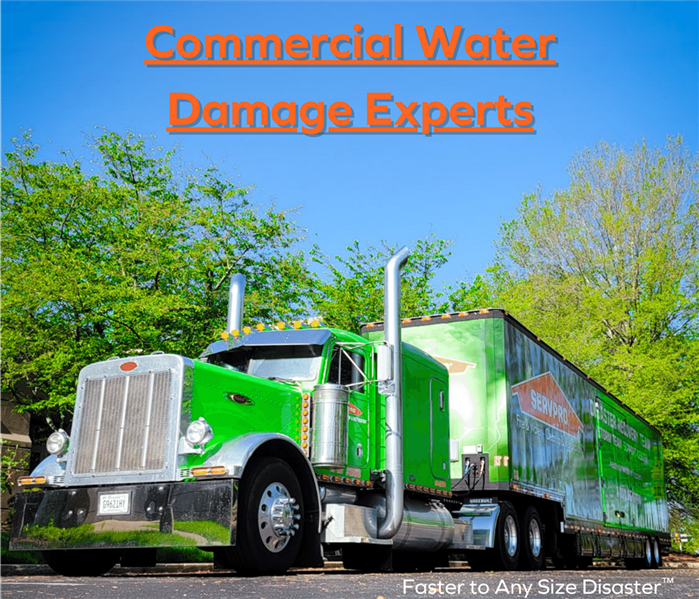 SERVPRO of Buford/Suwanee/Hamilton Mill is ready for whatever happens! We'll restore your business after any size of property damage.
SERVPRO of Buford/Suwanee/Hamilton Mill is ready for whatever happens! We'll restore your business after any size of property damage.
Commercial properties present unique risks when it comes to water damage in Dacula, GA. Unlike residential homes, which are usually one story and have easily accessible crawl spaces and attics, commercial buildings can be many stories high with flat roofs and multiple storefront windows. They also often have expensive specialized equipment that can be very costly to repair or replace if damaged by water. In this blog post, we will discuss the different parts of a commercial building that are at risk for water damage, as well as some tips on how to prevent it.
Plumbing Systems
The first and most obvious risk for water damage in a commercial property is the plumbing system. Because commercial buildings have more bathrooms, kitchens, and other water-using fixtures, they also have larger and more complex plumbing systems. These systems are often located in hard-to-reach places, making them difficult to repair if they spring a leak.
One of the main water damage challenges according to The Hartford Insurance is an improperly maintained sprinkler system. By law, most commercial buildings must have a fire sprinkler system, but many building owners forget to regularly maintain and test these systems. While a well-maintained fire sprinkler system can help prevent extensive fire damage in the event of a fire, improper maintenance or disaster planning can cause extensive water damage that can flood multiple floors.
Another plumbing risk is burst pipes. Commercial buildings, especially high rises tend to run at a higher pressure than residential buildings. Therefore, a burst pipe has the potential to release significantly more water than a home.
One of the ways in which we help commercial property owners prevent catastrophic property damage before it happens is through our app-based Emergency Response Planning program (ERP).
Roofing Systems
In addition to the plumbing system, there are a number of exterior commercial building components that can experience water damage. One of the most common is the flat roof. Because flat roofs are not sloped like traditional pitched roofs, they tend to pool water instead of shedding it. This can lead to leaks and eventually, if left unaddressed, major water damage.
Some common commercial roofing systems include:
- Built-up Roofing (BUR): Often called tar and gravel roofs, these commercial roofing systems are built with a semi-continuous membrane installed in layers, then covered in aggregate. While they are usually simple to maintain, best practices suggest inspecting the roof for deterioration and possible leak points at least twice yearly.
- Thermoplastic Single-Ply Membrane Roofing (PVC & TPO): These roofs are installed in large rolls that are then welded together at the seams with heat. The material is very durable and oil-resistant. However, the heat-welding methods require skilled installation, which can lead to weak points and leak-prone areas if not performed correctly.
- EPDM Roofing: Some roofers call these "rubber roofs" because the material they are made of, ethylene propylene diene monomer is very rubber-like. This kind of roof is derived from oil and natural gas, and appears dark gray or black. When installed correctly and with the highest thickness available, this type of commercial roof will last a very long time with little to no issues. Unless you experience storm damage in your area, an annual check for leaks around the roof penetrations should suffice.
Window Systems
Commercial window systems are built for durability and use, however, they can often present a unique water damage challenge for commercial facilities. Most aluminum glazing systems aren't intended to be 100% waterproof. Most commercial window systems are meant to limit water penetration during extreme circumstances while also weeping water back out to the exterior.
By directing all moisture to the sill flashing, storefront systems limit water penetration. It's critical that the sill flashing be installed correctly in order to avoid water damage. Making sure that sealant is put on the top of the rear leg before installing the sill is one of the most important aspects of a good installation.
The most essential aspect of maintaining water penetration with a storefront is end dam fastening and sealing. Water will enter the building through the jamb locations if end dams are not properly fastened and sealed. Improperly (or missing) end dams can cause significant water damage to the interior drywall or flooring around commercial storefront windows.
Like anything else in a building, time and the elements can cause wear and tear and failure of these commercial window water control systems.
Commercial Water Damage Inspection Services
So if you notice moisture or water damage around your storefront windows, you should consider calling SERVPRO of Buford/Suwanee/Hamilton Mill to inspect for potential water damage issues. Our technicians are trained to identify, troubleshoot, and restore all types of commercial water issues.
Call today to schedule your commercial service!
(770) 945-5355
Tips to Stay Safe during Fire Damage: SERVPRO of Buford/Suwanee/Hamilton Mill
3/29/2022 (Permalink)
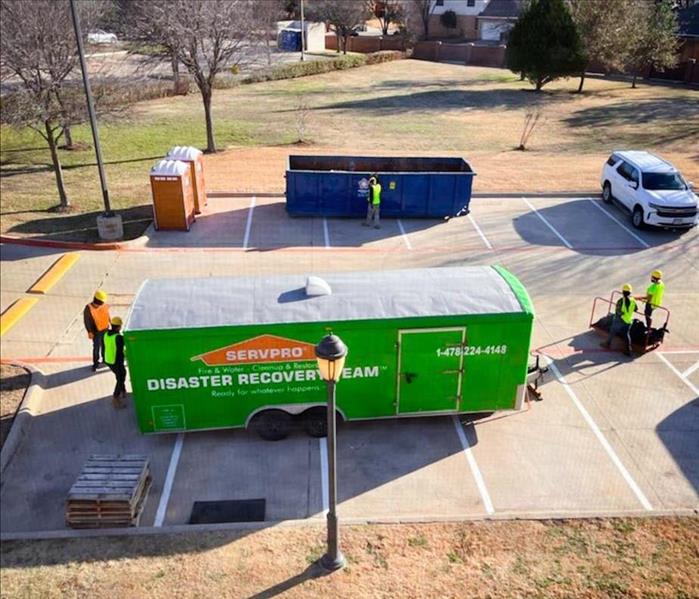 no matter how serious your property damage may be, SERVPRO of Buford/Suwanee/Hamilton Mill is your local fire damage expert. Call today!
no matter how serious your property damage may be, SERVPRO of Buford/Suwanee/Hamilton Mill is your local fire damage expert. Call today!
It's that time of year again - fire season in Sugar Hill, GA and surrounding areas. Between February and May, the weather gets hotter and drier, while the risk of house fires rises. A fire may start from a variety of sources, ranging from a faulty wire to an overloaded outlet to a kitchen mishap to a bonfire left unattended. It's critical to know how to react quickly and effectively if your home catches fire.
Here's What You Need To Know If A Fire Starts:
The first line of defense against a house fire is to know how to use the proper fire extinguisher for the situation. This simple procedure can help save lives and hundreds of thousands of dollars in property damage. If the fire spreads uncontrollably, evacuate immediately and stay away, then call 9-1-1. Leave all of your belongings where they are and save yourself and your loved ones.
If your clothing ignites, remember the old adage: Stop, Drop, and Roll.
It's critical to utilize the stairs if you live in a building with elevators in case of a fire. The elevator electrical system may be damaged by a fire, causing the shaft to operate like a chimney and rapidly fill up with deadly fumes.
Doors may be used to your advantage in a fire, potentially saving your life. If the doorknob or handle is hot, don't open it. If you can't exit through the primary route, look for another option. Do not open any doors that are warm to the touch.
Close any doors that might obstruct your exits, lay a wet towel beneath the doors, and call the fire department or 9-1-1 if flames, heat, or fire block your avenues of escape. Tell them exactly where you are so they can find you.
If you're near a window that you can't use as an escape, open it and wave a brightly colored cloth or use your phone flashlight to signal for help.
What To Do After a Fire
After a fire, it is important to contact a professional fire damage restoration company like SERVPRO of Buford/Suwanee/Hamilton Mill. We have the training, experience, and equipment to properly restore your home - "Like it never even happened."
If you try to clean up the fire damage yourself, you could end up making the situation worse both in your home and with your insurance company's process.
Trust the experts, and call today!
Spring Storms and Weather Events in the United States | SERVPRO® of Buford / Suwanee / Hamilton Mill
3/22/2022 (Permalink)
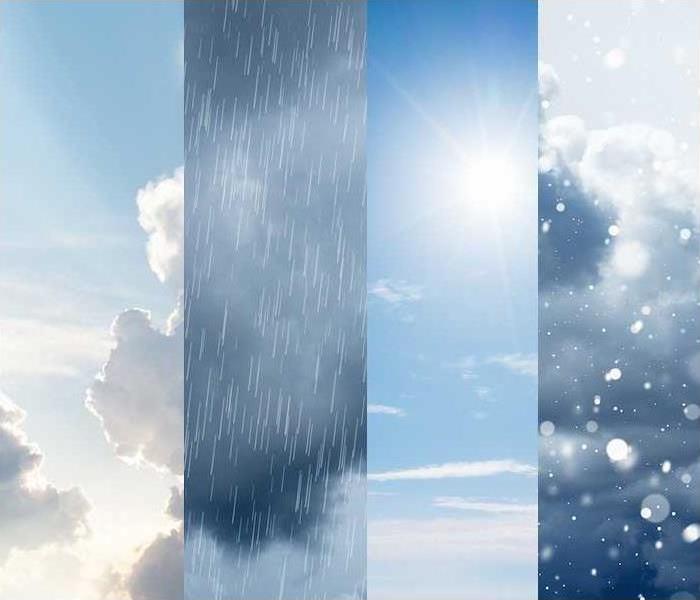 Extreme temperature changes can lead to severe weather. SERVPRO of Buford/Suwanee/Hamilton Mill is a click away if you experience any damage.
Extreme temperature changes can lead to severe weather. SERVPRO of Buford/Suwanee/Hamilton Mill is a click away if you experience any damage.
The United States is one of the world's largest countries, with a wide range of geographical features and varied landscapes. Different parts of the United States have different weather patterns. That means that some places have more dangerous and destructive weather than others.
Let's look at the weather patterns that may develop as spring approaches, when warm and cold air masses collide across the United States, and also what we can consider in Georgia.
The Pacific Northwest's spring months are prone to extreme rainfall, which may result in flooding and water damage. Snow will continue to accumulate at higher elevations, and the melting and runoff it produces can provide additional weather challenges.
The Northern states of Maine, New Hampshire, Vermont, Massachusetts, Connecticut, and Rhode Island will endure through the coldest weather. From Maine to North Dakota, people can anticipate chilly conditions and the potential for blizzards and significant snow even into late spring or early summer.
The Southwest and southern West Coast, on the other hand, should expect intense heat waves that may harm people and property. Hawaii will continue to be on high alert for tectonic activity-induced tsunamis in the South Pacific region, which includes Tahiti and Samoa.
From Iowa to Texas, the Midwest will need to be cautious for windstorms, Derechos, and potential wildfires, which might spread rapidly when winds are high and conditions are dry. Tornado Alley is one of the most hazardous regions in the world for tornadoes.
Finally, in the Southeast, we can anticipate a broad selection of severe weather events, including thunderstorms and tornadoes in landlocked regions, as well as early-season hurricanes along the coast later in the spring. Late-season snow has afflicted several locations throughout Middle Tennessee.
Extreme weather may occur in any location in the United States. While it varies from state to state, being aware of and prepared for severe weather is never a bad idea.
Help is only a phone call away if you suffer severe weather-related damage caused by water, fire, or other elements. Call our SERVPRO team for prompt, professional restoration.
5 Easy Maintenace Tips to Help You Keep Your House Safe From Water Damage
3/14/2022 (Permalink)
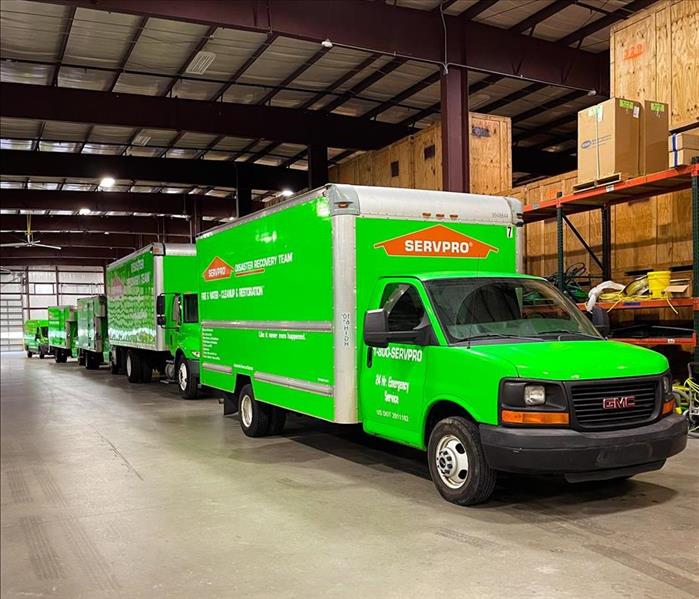 SERVPRO of Buford/Suwanee/Hamilton Mill keeps its trucks ready to respond immediately to your water damage emergency.
SERVPRO of Buford/Suwanee/Hamilton Mill keeps its trucks ready to respond immediately to your water damage emergency.
Water damage is an expensive and damaging occurrence. SERVPRO of Buford, Suwanee, and Hamilton Mill has discovered on numerous occasions that careful home or business property upkeep can decrease the risk and expenses of water damage. Living through a water damage restoration event can be stressful, but you can help prevent flooding from structural or routine maintenance concerns by following these simple tips.
1)To avoid dampness and moisture around your windows, replace old caulk around them.
We get a lot of calls for window caulking in Buford, GA and Suwanee, GA. Caulking your windows not only prevents water leaks, but it also helps to keep out drafts. It's a simple procedure that any homeowner can perform. Most window caulk should last approximately five years before needing to be replaced; however, you should check your caulking every year and replace it if it develops cracks or begins to pull away from the glass.
You should also inspect your exterior door flashings for any holes or rust that might allow water entry. You may also help prevent early flashing failure by properly caulking your doors.
2) To minimize water damage risk, check your water heater.
When it comes to our emergency water cleanup services, water heater problems are all too frequent. You may avoid a major water heater flood in your house by maintaining it on a regular basis. To prevent the formation of pressure that might result in a water leak, make sure the water heater's thermostat is set to regulate the temperature properly.
It's often the case that water heaters develop rust or silt inside, resulting in an odd taste or smell in the water. If your water starts to make unusual sounds, it may be time for a checkup or a new water heater.
3) Examine your water hoses and connections for leaks and replace them if they appear to be worn.
Look for any holes, kinks, fraying, wear, or corrosion on the hoses and connections. If you find any damage, get it fixed right away. To avoid unexpected water damage problems, most manufacturers and plumbers recommend replacing water hoses and connectors every 3-5 years.
4) Make sure the roof and gutters are clear of debris and that your attic shows no signs of moisture damage.
Rainwater backing up and overflowing onto your roof may harm the roofing material and seep into the house, causing problems.
Look for leaking flashing around vents, valleys, chimneys, pipes, and skylights. Anywhere on your roof where there are holes or connections is a potential source of leaks later on. If the flashing becomes deformed due to weather, rusted, or loses its seal, water might flow into your property.
Examine the interior of your attic for moisture or mold growth. If you detect damp, injured, or moldy insulation, decaying or discolored boards or ceiling panels, or puckering in the sheetrock, you may have a leak on your hands.
5) Check for any leaks or flooding in the HVAC condensation lines by cleaning and inspecting them.
When HVAC condensation lines are clogged, water leaks out, resulting in water damage and flooding in surrounding areas of your property. Check your condensation lines every month to ensure they're clean.
To clean out obstructions and grime from your condensate drain, pour one-half cup of plain, white vinegar four times a year down the drain. Bleach should not be used since it may damage your metal drain pan and result in deterioration. If you detect an abundance of debris or mold, our SERVPRO experts can assist you with any water damage cleanup.
We are Here to Help for All of Your Water Repair Needs
If you or someone you know need water damage repair service, contact our staff at SERVPRO of Buford/Suwanee/Hamilton Mill!
Save our phone number for when you need help in the future, or contact us right away for a quick response from one of our IICRC educated water restoration professionals.
We are always Here to Help!
5 Safety Tips for Cooking on a Grill
2/21/2022 (Permalink)
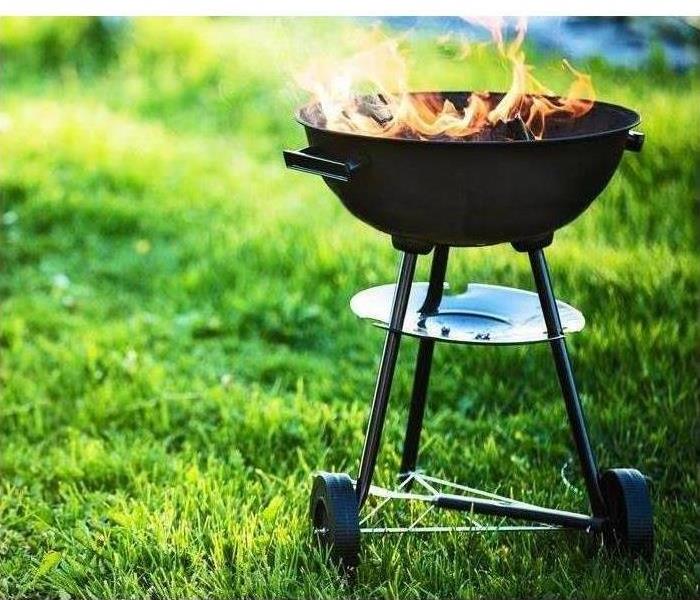 If you stay safe, grilling can be a fun and enjoyable pastime.
If you stay safe, grilling can be a fun and enjoyable pastime.
Cooking on a Grill: 5 Safety Tips
Having a family barbecue and cooking on the grill in your backyard in Rest Haven, GA can be a great way to spend your days during warmer weather. However, it can become dangerous if you’re not careful. A grill fire can happen quickly, so keep these tips in mind when you’re grilling to avoid injuries or damage to your property.
1. Keep the Grill Away From the House
While many people like to grill on a deck, this can lead to disaster if a fire occurs. It could spread to your house and cause a lot of fire and smoke damage. Fire remediation can be a time-consuming process and you could lose valuable and sentimental objects, so it is best to use your grill as far from the house as you can.
2. Only Use Fluids Made for Grills
If you use a charcoal grill, be sure to use only lighter fluid that is specifically made for this purpose. Other flammable liquids might not be safe for use around food. They can also more easily cause a grill fire. You should also never add more fluid after it has already been ignited.
3. Keep the Grill Clean
You should remember to clean your grill regularly. Built up fat and grease can cause a barbecue fire to flare up and become a safety hazard.
4. Open the Grill Before Turning On the Gas
If you have a gas grill, always open the lid of the grill before turning on the gas. If you turn the gas on while the grill is still closed, the gas will build up and can create a fireball when ignited.
5. Never Leave the Grill Unattended
When you are grilling, you should always make sure that someone is there to keep an eye on it. If a fire were to start while the grill was unattended, it could cause quite a bit of damage before you even notice.
Because cooking on a grill can be dangerous, you should always take proper precautions to avoid a grill fire. If you stay safe, grilling can be a fun and enjoyable pastime.





 24/7 Emergency Service
24/7 Emergency Service









